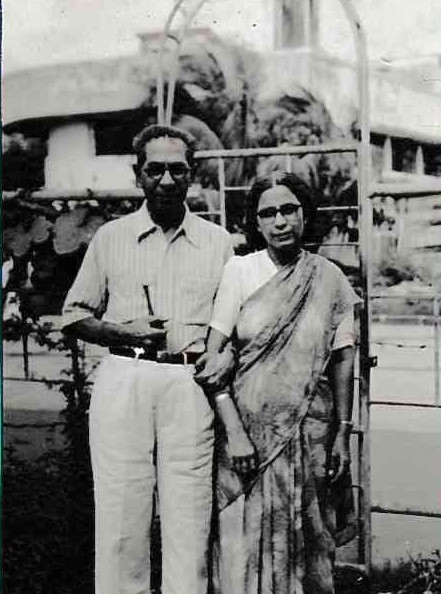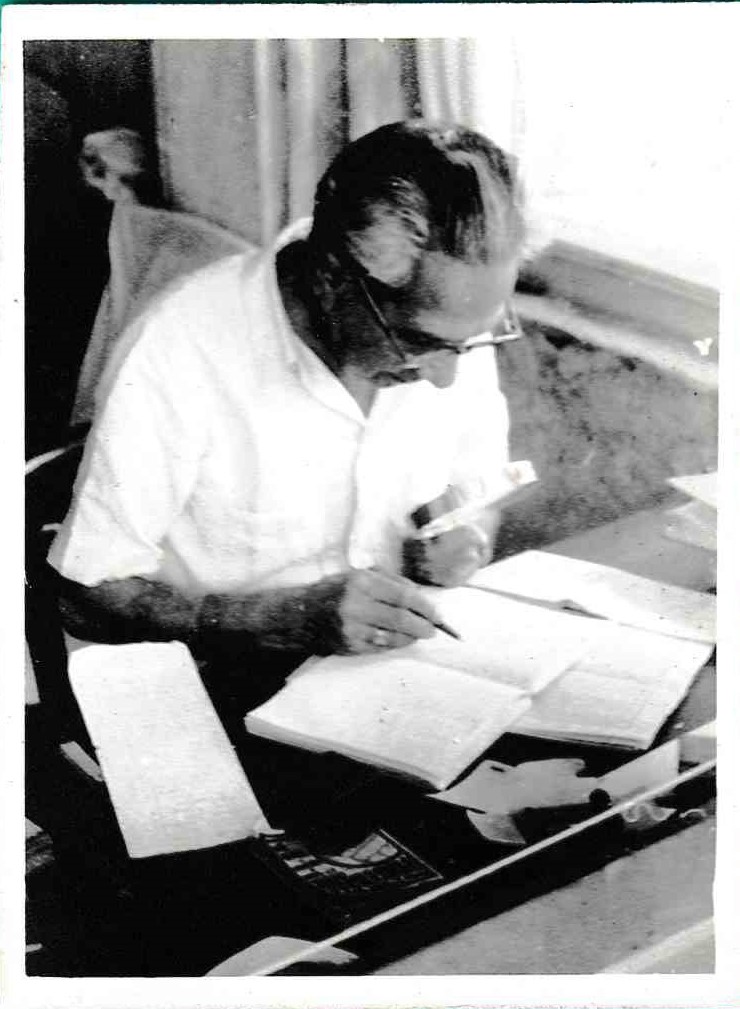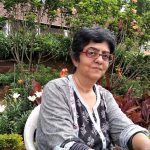
Chando believed that even if he didn’t agree with what his wife was doing, he would fully back her right to do it. She was vegetarian, he was the opposite. It was fine with him that she wanted to wear khadi and fight for the country.
By Saaz Aggarwal
Chuhar, or Chando Sitaldas Kripps, was one of triplets. After him came Cheti, and they looked quite alike. The last to emerge was Chetan – wizened, dark, curled up, the runt of the litter. In later years he would joke, “These two fought with me and wouldn’t let me grow. Look at me, so black because of them!” Born in Hyderabad in 1894, the three remained full of fun and mischief as long as they lived. They were nineteen siblings, eleven from their father’s first wife (the eldest three cared meticulously for the rest when she died) and eight from the second.
Chando, in particular, was a wanderer. Sitaldas was a station master on the line between Hyderabad and Karachi and when his eldest son moved to Karachi, Chando soon followed. When it was learnt that Chando had decided to run away to sea, he was tied to a bedpost. However, he set up such a strong resistance that he sailed on the next ship with the family’s blessings.
Chando, sixteen, arrived in New York with USD5 in his pocket. His daughter, Chandra ‘Kiku’, grew up hearing his fond remembrances of how he worked his way across the United States waiting tables and doing odd jobs, until he reached California. His ambition was to be a part of the glamour world of Hollywood, and he enrolled at University of California, Berkeley, working and giving tuitions while he studied. On graduation, he joined a film studio and worked as a director. When he found his childhood dream hollow, he and his friend Tom bought a second-hand car for USD20 and set out on their next adventure – a journey across the US. Emerging from Death Valley, longing for a drink, they got a policeman (in this state where Prohibition had been recently imposed) to point them in the right direction and then look the other way.

In Canada, Chando worked as a school teacher. In the early 1920s, in response to his family’s pleas that he come home – and doubtless ready for his next adventure – he arrived back in Karachi. A routine desk job would have been torture; instead he toured India for some years as a travelling salesman. One day in 1926, he returned to a temporary base after a long gap, to find a stack of letters from home. And was astounded to learn that his marriage was to take place in three days’ time. Cheti had selected his bride from one of the eligible girls of the Chandiramani family she had married into. At the wedding, Gomi’s ghoonghat covered her face completely. In later years, Chando’s favorite party story was that he had never seen his wife until after they were married, by which time it was too late.
Gomi, as Cheti had well known, turned out to be a good match. Her father had strongly resisted her instinct to join the marches and processions of the freedom movement. And Chando believed that even if he didn’t agree with what his wife was doing, he would fully back her right to do it. She was vegetarian, he was the opposite. It was fine with him that she wanted to wear khadi and fight for the country. One day, the marchers protesting outside a club raised their eyebrows because Chando was sitting inside, having a drink. Gomi explained that she may not be a drinker but so what if her husband was?
In any case, she was not protesting against him, simply demanding freedom from British rule.
One day, a jhande salaam – a revolutionary meeting at which the INC flag would be illegally hoisted – had been planned, and the person in charge was arrested the previous night. Gomi willingly hoisted the flat in his place, and was duly hauled off to prison with the other protesters.
Gomi endured two prison terms, one of about six weeks and another of two long years. Quite naturally, she was close to Parpati Gidwani, Jethi Sipahimalani and the other women who led the freedom struggle in Sindh and spent time with them both in jail and outside it. Even after her children were born (twelve long years after the marriage), she continued marching and making speeches. She and her sister Sati, who did Master’s at Shantiniketan after graduating from DJ Sind, spun khadi on a charkha. It was only after Independence that they wore anything other than khadi.
Gomi was the daughter of Nindhibai and Lilaram Issardas Chandiramani, a well-known advocate of Sukkur. They had eight children and adopted three more: her sister’s, who died in childbirth, the same age as her first son, and the daughters of Pesudas Chandiramani, Lilaram’s business partner, when they were left motherless. (In later years, Gomi and three of her sisters, one unmarried and the rest widowed, made their home along with Gomi’s daughter Indra, and lived very happily together.)
During the Second World War, Chando had taken a short service commission in the Royal Navy, with a shore job in the Supplies Department. He was stationed in Bombay when Kiku was born, moving to Calcutta when she was three.
Kiku enjoyed the holidays at her nana’s home in Sukkur, surrounded by her loving masis and mamas. In 1947, Chando was transferred to Karachi and until his family accommodation was arranged, she went to school on the takri in Sukkur, put into a wheel barrow with two other young children and pushed up the hill! Instead of notebooks and pencils, like city children, they had wooden boards called takhtis and later black slates with white chalk. The family home overlooked the beautiful Sindhu and the children were sometimes taken to Sadhbelo by boat where they enjoyed the dhodhochutney.
On most evenings, they walked to the town Centre and ate golgappas followed by ice cream or candy floss.
After Partition, Chando brought his family to Bombay on SS Ekma and after some time in the Vile Parle home of his cousin Tekchand Mansukhani, a PWD engineer, moved to Rashid Mansion in Colaba. The home soon filled up with family members displaced from Sindh – at one point there were forty-one.
At night, the floor of the inner bedroom was layered with mattresses covered with sheets, and you had to go in, find a place, lie down and sleep.
Kiku had been studying at Sitaram Premier School in Karachi and resumed when its principal arranged with the Robert Money School at Grant Road for the use of classrooms for her students and teachers (two were Chando’s sisters), from 7 to 11 am, before the regular school began at 11.30.
A Sindhi-medium school was not to Kiku’s taste and she finished her schooling at St Anne’s, Colaba. Her cousin Rukmani Kripalani, with an MBBS from Grant Medical College in Bombay, opened a maternity home in Niagara building nearby. Another cousin, Teju, got a job with the Bombay Municipality, and (as Kiku puts it) would go around inspecting this and that. Gomi and her sister-in-law Lachhimi ran the kitchen and it was amazing that Lachhimi would always remember who liked what. Kiku remembers that even years later, long after everyone had found homes of their own and dispersed and grown old, if anyone called on her chachi, she would instruct her family what they should be fed because she knew what they enjoyed most.
Kiku was nineteen when she graduated from Sydenham College. With her parents’ genes, there was no question of learning shorthand and typing and becoming a secretary! Instead she joined BOAC, stationed in Calcutta. Of the six recruits, three were Sindhi: her, Indra Malani and Shanta Gopaldas. Kiku flew for three-and-a-half years and for one-a-half worked as ground staff at Calcutta airport looking after VIP passengers and unaccompanied children of expatriates from the tea gardens coming home for holidays from boarding school in Britain, and desperately homesick on the way back. She then left for London and took up a job with Air India, returning to Calcutta to marry her boyfriend, Murli Uttamchandani. Today, Kiku lives in London and visits Calcutta every year to spend time with her daughter Kiran.
(Excerpted from ‘The Amils of Sindh’ by Saaz Aggarwal)
__________________
 Saaz Aggarwal is an independent researcher, writer and artist based in Pune, India. Her body of writing includes biographies, translations, critical reviews and humor columns. Her books are in university libraries around the world, and much of her research contribution in the field of Sindh studies is easily accessible online. Her 2012 Sindh: Stories from a Vanished Homeland is an acknowledged classic. With an MSc from Mumbai University in 1982, Saaz taught undergraduate Mathematics at Ruparel College, Mumbai, for three years. She was appointed features editor at Times of India, Mumbai, in 1989.
Saaz Aggarwal is an independent researcher, writer and artist based in Pune, India. Her body of writing includes biographies, translations, critical reviews and humor columns. Her books are in university libraries around the world, and much of her research contribution in the field of Sindh studies is easily accessible online. Her 2012 Sindh: Stories from a Vanished Homeland is an acknowledged classic. With an MSc from Mumbai University in 1982, Saaz taught undergraduate Mathematics at Ruparel College, Mumbai, for three years. She was appointed features editor at Times of India, Mumbai, in 1989.
Courtesy: Saaz Aggarwal